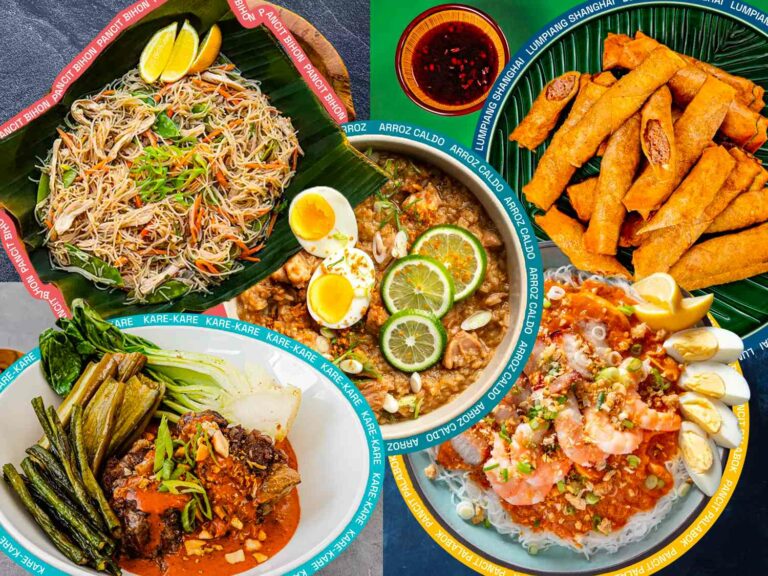Introduction: The Rich Culinary Heritage of the Philippines
The Philippines is a country with a rich culinary heritage that has been influenced by various cultures. From indigenous dishes to Chinese, Spanish, and American-influenced cuisine, Filipino food is a delicious fusion of flavors and ingredients. Filipino cuisine is characterized by its bold and complex flavors, with dishes that are both hearty and satisfying.
Filipino dishes commonly use a combination of sweet, sour, and savory flavors that are made with fresh ingredients such as meats, seafood, vegetables, herbs, and spices. Filipino food is also known for its use of vinegar, soy sauce, and fish sauce, which adds a unique taste to every dish.
Adobo: The Iconic Dish of the Philippines
Adobo is perhaps the most well-known Filipino dish, and it is often considered the country’s national dish. Adobo is a savory and tangy stew made with meat (usually chicken or pork) that is cooked in a mixture of vinegar, soy sauce, and spices. The dish is then simmered until the meat is tender and the flavors have melded together.
Adobo can be served with rice or as a filling for tacos or burritos. Some variations of adobo include the addition of coconut milk (giving it a sweeter taste) or the use of seafood instead of meat. Adobo is a versatile dish that can be adjusted to suit different tastes, making it a favorite among Filipinos and foreigners alike.
Sinigang: A Hearty and Sour Soup
Sinigang is another popular Filipino dish that is known for its sour and savory taste. This hearty soup is usually made with pork or fish and flavored with tamarind, which gives it a distinct sour taste. Other ingredients typically include vegetables like tomatoes, onions, and leafy greens like kangkong.
Sinigang is a comforting and filling dish that is perfect for cold or rainy days. The sourness of the soup is balanced with the sweetness of the vegetables, creating a delicious and healthy meal that is easy to prepare.
Kare-Kare: A Nutty and Savory Stew
Kare-Kare is a rich and savory stew that is made with oxtail, tripe, or beef, slow-cooked in a peanut butter-based sauce. The dish is flavored with a mix of vegetables, such as eggplant, string beans, and bok choy. Kare-Kare is typically served with steamed rice and a side of bagoong (shrimp paste).
Kare-Kare is often served at special occasions, such as weddings or fiestas. The dish has a nutty and savory taste that is unique to Filipino cuisine, and it is a testament to the country’s rich culinary heritage.
Lechon: The Pride of Filipino Roasting
Lechon is a whole roasted pig that is a staple in Filipino celebrations. The pig is roasted over an open flame until it is crispy on the outside and tender on the inside. The dish is often served with a vinegar-based dipping sauce.
Lechon is a prized dish in the Philippines, and the preparation and serving of it is often considered a source of pride for Filipinos. The dish is a popular centerpiece at special events and holidays, and it is a must-try for anyone visiting the Philippines.
Bibingka and Puto Bumbong: Filipino Holiday Delights
Bibingka and Puto Bumbong are two popular Filipino desserts that are often served during the holiday season. Bibingka is a sweet rice cake that is traditionally cooked in a clay pot and topped with salted eggs, cheese, and coconut. Puto Bumbong, on the other hand, is a purple-colored rice cake that is steamed in bamboo tubes and flavored with coconut and muscovado sugar.
Both Bibingka and Puto Bumbong are usually sold in stalls along the streets or at night markets during the Christmas season. These desserts are a delicious way to cap off a hearty Filipino meal and to experience the country’s rich culinary heritage.
In conclusion, Filipino cuisine is a delicious blend of flavors and ingredients that reflects the country’s rich culinary heritage. From the iconic Adobo to the hearty Sinigang and the delicious Kare-Kare, Filipino dishes are flavorful, satisfying, and easy to prepare. If you’re planning to visit the Philippines or try out Filipino cuisine, we highly recommend that you give these dishes a try.

